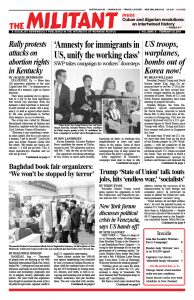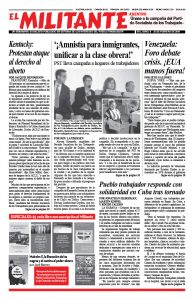Printed below are two excerpts that give a picture of the workers and farmers government that emerged from the revolution in Algeria that in 1962 overthrew French colonial rule, its impact in France and the U.S., and its leaders’ shoulder-to-shoulder collaboration with the Cuban Revolution. The first is from “On the Character of the Algerian Government,” a resolution drafted by Socialist Workers Party leader Joseph Hansen in 1964. It appears in the Education for Socialists booklet “For a Workers and Farmers Government in the United States.” The second is from SWP leader Mary-Alice Waters’ “The Cuban Revolution Was Not Alone,” from Cuba and the Coming American Revolution by SWP National Secretary Jack Barnes. The latter is copyright © 2001 by Pathfinder Press. Reprinted by permission.
An essentially bourgeois state apparatus was bequeathed to Algeria. A crisis in the leadership of the FLN (Front de Libération Nationale) came to a head July 1, 1962, ending after a few days in the establishment of a de facto coalition government in which Ferhat Abbas and [Ahmed] Ben Bella represented the two opposing wings of neocolonialism and popular revolution. The struggle between these two tendencies within the coalition ended in the reinforcement of the Ben Bella wing, the promulgation of the decrees of March 1963 and the ouster successively of [Mohammed] Khider, Ferhat Abbas, and other bourgeois leaders although some rightist elements still remain in the government. These changes marked the end of the coalition and the establishment of a Workers and Peasants Government.
As is a characteristic of a Workers and Peasants Government of this kind, the Algerian government has not followed a consistent course. Its general direction, however, has been in opposition to imperialism, to the old colonial structure, to neocolonialism and to bureaucratism. It has reacted with firmness to the initiatives of would-be new bourgeois layers, including armed counterrevolution. Its subjective aims have repeatedly been declared to be the construction of socialism. At the same time its consciousness is limited by its lack of Marxist training and background.
The question that remains to be answered is whether this government can establish a workers state. The movement in this direction is evident and bears many resemblances to the Cuban pattern. A profound agrarian reform has already been carried out, marked by virtual nationalization of the most important areas of arable land. Deep inroads have been made into the old ownership relations in the industrial sector with the establishment of a public and state-controlled sector. Yet to be undertaken are the expropriation of the key oil and mineral sector, the banks and insurance companies, establishment of a monopoly of foreign trade, and the inauguration of effective counter measures to the monetary, financial, and commercial activities of foreign imperialism.
Among the most heartening signs in Algeria are (1) in foreign policy the establishment of friendly relations with Cuba, Yugoslavia, China, the Soviet Union, and other workers states with the possibility this opens up for substantial aid from these sources; (2) the active attitude of the government toward developing the colonial revolution in such areas as Angola and South Africa; (3) within Algeria the establishment of the institution of “self-management.” “Self management,” with its already demonstrated importance for the development of workers and peasants democracy, offers the brightest opening for the establishment of the institutions of a workers state. …
The appearance of a Workers and Peasants Government in Algeria is concrete evidence of the depth of the revolutionary process occurring there. It is of historic importance not only for Algeria and North Africa but for the whole African continent and the rest of the world.
❖
A few months after the Bay of Pigs, I headed to France on a university junior year abroad program. The Algerian independence struggle, paid for in blood by some one million Algerians, was rapidly approaching victory. The great movie depiction of this struggle, Battle of Algiers, captures much of the courage and determination of the Algerian people, as well as the immeasurable brutality of the French imperialist forces. No one should miss it.
In the fall of 1961 and spring of 1962 Paris resembled a city under siege. Following a failed coup attempt, the Secret Army Organization (OAS), a clandestine fascist group based in the officer corps of the French army, had unleashed a campaign of bombings and assassinations in the capital aimed at bringing down the French government before it conceded defeat and recognized Algerian independence. Paratroops armed with submachine guns stood guard twenty-four hours a day on every street corner, and plastic explosives went off nightly in mailboxes and other public locations throughout the city.
Student antifascist committees were active in every faculty. I joined in the regularly organized demonstrations challenging the prohibition on street actions. Facing off against the much-hated special police force, the CRS, injuries and arrests were inevitable. In February 1962 eight demonstrators were trampled and suffocated to death as those escaping a CRS attack fled into an abandoned metro station, the exit from which had been sealed. A few days later more than a million people poured into Paris streets to join the funeral cortege to the Père Lachaise cemetery, where the martyrs of the Paris Commune are also buried.
Despite the casualties still to come, the war was over. The people of Algeria had won. A few months later the Evian Accords were signed, ceding independence to Algeria after more than 130 years of French colonial rule. A workers and farmers government soon came to power, with National Liberation Front leader Ahmed Ben Bella at its head. …
The liberation struggle in Algeria had an impact on layers of young people and fighters against oppression far beyond North Africa and France, of course. Malcolm X was one of them. At a May 1964 meeting of the Militant Labor Forum in New York City, Malcolm pointed out that while only a few years earlier Ben Bella had been in the prisons of French imperialism, “today they have to negotiate with him because he knew that the one thing he had on his side was truth and time. Time is on the side of the oppressed today, it’s against the oppressor. Truth is on the side of the oppressed today, it’s against the oppressor.” During both of his trips to Africa and the Middle East in 1964, Malcolm traveled to Algeria to meet with fellow revolutionaries.
There were strong ties linking the Algerian and Cuban revolutions. The years immediately following independence from France saw close and growing collaboration between Havana and Algiers to aid anti-imperialist struggles from the Congo to Argentina and apartheid South Africa, and to defeat imperialism’s attempts to overturn the Algerian and Cuban revolutions themselves. …
The first large-scale internationalist mission of Cuban volunteers was the dispatch of tanks and a column of troops under the command of Efigenio Ameijeiras, the head of the Revolutionary National Police battalion that had fought so tenaciously at Playa Girón. They went to Algeria in October 1963 to help the revolutionary government repel a U.S.-backed invasion by Moroccan troops.
With the overthrow of the Ben Bella-led workers and farmers government in June 1965, the defeat of the anti-imperialist forces in the Congo later that year, and the withdrawal from the Congo of the Cuban internationalist volunteers headed by Che Guevara, the era of that type of close revolutionary collaboration between Havana and Algiers came to an end.

